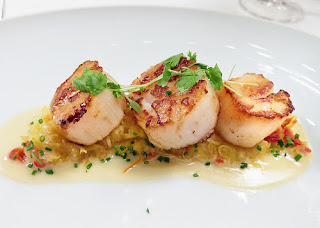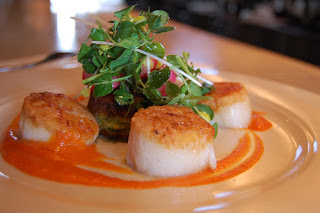from
Behind the French Menu
by
Bryan G. Newman
behindthefrenchmenu@gmail.com
Scallop
on the half-shell.
www.flickr.com/photos/acme/290654197
The Saint Jacques
The King scallop or Great Atlantic Scallop.
(The St. Jaques and Saint Jaques).
(For the Vanneau or Pétoncle - The Queen scallop, or Queenie; see the second half of this post).
King scallops are the largest and the most famous member of the scallop family. King scallops have shells from 12 to 14cm (4.75” to 5.50”) across, with some even larger. The taste of the white flesh of the king scallop is delicate, slightly sweet and its texture is uniquely soft but firm. To be genuinely appreciated, the king scallop must be served very, very lightly fried, grilled, or roasted. One minute too long and their distinctive taste will have gone, and their texture will be firmer.
Scallops
with steak and asparagus.
www.flickr.com/photos/gpeters/3249409593/
In France, nearly all the king scallops, in their shells, come from the Atlantic. There are scallops in the Mediterranean, where the king scallop is called the St. James Scallop or Great Mediterranean Scallop. Under the name St James, this scallop comes with a story related to pilgrimages from France to Spain and much more. The stories are interesting but it is not a food story, and it is too long for this post, and so I move on. However, this is a book on food, and when I talked to fishermen in the old Marseilles port they told me that the Mediterranean and Atlantic King scallops are the same. I carried out my own tests, and I can affirm that they taste the same).
Noix de Saint-Jacques means the nut or meat of the scallop.
French menus tell the diner how the scallops will be served. A menu listing for Saint-Jacques or Noix de Saint-Jacques means the meat of the king scallop without the shell.
Coquille Saint-Jacques, the scallop served in its shell
When the menu listing is for Coquille Saint-Jacques, then the scallop is served in its shell, the word coquille means shell. A single scallop served in its shell, or rather on its shell, is enough for a very small entrée, the French first course. A menu listing for a main course of Coquille Saint-Jacques should be for three or more scallops. Two or more scallops may be served on the half-shell, but that is just a display. The scallop, the part we eat, is the adductor muscle, and there is only one in each shell.
Hand-dived scallops.
Scallops
caught by divers are more expensive, but leave something for next year. Those
interested in conservation will not buy those caught by dredging, which destroys
much of the ocean floor.
King scallops on French Menus:
Feuilleté de Saumon et de St-Jacques, Sauce Nantaise – Salmon and scallop meat served together in a puff pastry casing with a Sauce Nantaise. Sauce Nantaise is a white butter sauce and a favorite for fish and shellfish. This sauce is named after the lovely city of Nantes in the Pay du Loire.
Noix de Saint-Jacques Juste Saisies – The meat of king scallops very lightly and perfectly cooked. Juste saisies means very, very carefully cooked; even slight over-cooking can ruin the taste and texture of scallops. When scallops are prepared in fish stews and in other dishes some of their texture may remain, but their taste will be like the other parts of the stew. The menu listing above notes the Noix de Saint-Jacques, the nut or meat that makes it clear that the serving is the meat only. The shell, the coquille, which is only decorative, is not part of this dish. With scallops, Juste Saisies or Juste Cuit means perfectly cooked.
Two scallops on the
one-half shell.
www.flickr.com/photos/stuart_spivack/14940892035/
Noix de St Jacques et Gambas Poêlées au Noilly Prat sur un Lit d'Épinards – The meat of king scallops, and large shrimps flavored in Noilly Prat and served on a bed of spinach. Noilly Prat, often just called Noilly, was France’s first vermouth, and it still is the most popular vermouth,
Seared
Diver Sea Scallops
with
tomato confit & lemon garlic butter
www.flickr.com/photos/ralphandjenny/6766466185/
Saint-Jacques, au Lard Flambées au Whisky - Scallop meat served with or rolled inside rashers of bacon, and flambéed with Scotch whisky. (When the word whiskey has an e then you know it is NOT Scotch).
Coquille St. Jacques Couraillée – A king scallop served in its shell with its roe. Scallops are only occasionally cooked in their shell; chefs control the cooking much better when the scallop is in the frying pan; the shells are mostly for decoration. The roe, with its slightly stronger taste, is considered a delicacy by some and discarded by others. If the roe is red, it comes from a female, while yellow or white roe comes from a male.
Scallops
on the half shell with roe.
www.flickr.com/photos/stone-soup/290079986/
If you see a menu listing for scallops from June through September, then the scallop is imported or frozen. Harvesting in French waters is forbidden from June through September for conservation. The noix, the scallop meat, may be frozen but whole scallops may be chilled but will not be frozen.
Scallops
with carrot sauce.
www.flickr.com/photos/stuart_spivack/3490068992
Scallops in North America
Larger North American scallops are called American Sea Scallops or Sea Scallops. On North American French restaurant menus they may still be called Coquille St. Jacques and not too much damage will be done. I was told that Canada is farming scallops of all sizes; I imagine that France will soon be doing the same if they haven’t already begun.
The king scallop in the languages of France’s neighbors:
(Catalan -
petxina de pelegrí del Mediterrani ), (Dutch – jakobsmantel.
sint-jakobsschelp, grote mantel ), (German – kammuschel, grosse
pilgermusc), ) (Italian - cappasanta, conchiglia di San Giacomo, grande
pettine), (Spanish - veiera, concha de Santiago, concha de peregrine, vieiras
rey),
The king scallop in other languages:
(Chinese - 扇贝 ), (
(Greek – χτένι), (Hebrew – zdafat hamelech - צדפת
המלך ) (Japanese - kaibashira),(Rumanian - scoică Saint
Jacques), (Russian - гребень Максимус - greben'
Maksimus ), (Latin -pecten maximus or pecten jacobeus)
Vanneau (Le ) or Pétoncle –The Queen Scallop or Queenie.
Queen scallops.
Photograph courtesy of Marine Stewardship Council
Vanneaux or Pétoncle
The Queen scallop or Queenies are sometimes confused with the King scallop. The queen is, however, noticeably smaller than the king scallop; usually no more than 8-9 cm (3.25”), and most about 7cm (2.75) across. Queen scallops are considered to be just as tasty while they are much less expensive than the king scallop; that price difference should be reflected on the menu.
The Queen scallop on French menus:
Éclade de Vanneaux sur Lit d'Aiguilles de Pin – Queen scallops baked on a bed of pine needles. The tradition of cooking mussels in pine needles is claimed by the fishermen and women on the Atlantic coast of the French région of Poitou-Charentes. Originally this dish would not have contained scallops, they were too expensive and would have been sold; the recipe was created for mussels. Today, in restaurants, a bed of pine needles cooking mussels and scallops on the sands of Poitou-Charentes will have been replaced by pine needles baking in a restaurant oven.
(Poitou-Charentes, since 1-1-2016, has been
part of the new super region of Nouvelle Aquitaine. The departments of Charente, Charente-Maritime, Deux-Sèvres, and Vienne make up Poitou-Charentes and are famous for Cognac, Oysters, Lamb, Melons, Goat’s milk cheeses, and much more).
A
serving of queen scallops on the half-shell.
www.flickr.com/photos/sarahvain/34397259201/
Pétoncles Poêlés Sauce aux Pommes Vertes – Queen scallops fried with a green apple sauce. France’s favorite cooking apple is the Granny Smith, and that is probably the apple used with this dish.
Pétoncles de Côtes au Beurre d'Escargots 12 Pièces – Locally fished queen scallops prepared with snail butter sauce, 12 pieces. Snail butter sauce is a compound butter made with butter, crushed garlic, shallots, parsley, and pepper, but no snails. This butter sauce was created for snails, and that gave it its name. The same butter, when used for other dishes, maybe on the menu as garlic butter sauce and they as garlic butter sauce it may be served with steaks and seafood
Salade d'Écrevisse et Pétoncles au Vinaigre de Framboise – A salad of freshwater crayfish and queen scallops served with raspberry vinegar. The only meat in a crayfish is in its tail, so hopefully, the server will confirm that only the tail is served.
The smaller Western Atlantic scallops
The Bay Scallop, the Cape Cod Scallop, or Atlantic Bay looks like Europe’s Queen Scallop and will be prepared with similar recipes.
The Queen scallop in the languages of France’s
neighbors:
(Catalan
– xel, xelet), (Dutch - wijde mantel), German - gedeckelte
kammmuschel), (Italian – canestrello; canestrello, pettine), (Spanish -
zamburina, volandeiras.),
The Queen scallop in other languages:
(Chinese
- 又稱女王海扇蛤 -皇后扇贝), (Hebrew - masrek rav-gal- מַסְרֵק רַב-גַּל), (Ja[anes - kaibashira), (Russian -
kоролева гребешок - koroleva grebeshka ), (Latin - aequipecten
opercularis).
More about scallops.
I enjoy visiting the food markets in France, and apart from the products, scents, and choice, they are incredibly educational. In one market, a fishmonger explained that scallops and clams are different members of the bivalve family; this fishmonger knew his scallops because I double-checked. Now I know that scallops differ from other mollusks because they can swim and they also have eyes, even though their eyesight is not very good. A scallop moves along the ocean floor by opening and closing its shell, whereas clams, mussels, and oysters stay put unless they get washed to new locations by ocean currents.
The same fishmonger showed me how he sells the fresh scallops in their shells with the adductor muscle intact. The adductor muscle is the part we eat, plus, of course, in season the roe, For part of the year this French fishmonger also sells top of the line King scallops imported from Scotland, and these he said are second to none. He also sells fresh scallops without their shells for those who do not need those decorative additions. He also apologized while telling me that he also sells frozen scallops, without their shells. He pointed out imported bags of frozen scallops and said he does not take the frozen scallops home; he and his family only eat the much tastier fresh scallops.
Behind the French Menu
--------------------------------
Behind the French Menu
by
Bryan G. Newman
behindthefrenchmenu@gmail.com
Copyright 2010, 2013, 2018, 2019, 2024.
--------------------------------
Searching for the meaning of words, names or phrases
on
French menus?
Just add the word or phrase that you are searching for to the words "Behind the French Menu" (best when including the inverted commas) and search with Google, Bing, or another browser. Behind the French Menu’s links include hundreds of words,
names, and phrases that are seen on French menus. There are over 450 articles
that include over 4,000 French dishes with English translations and
explanations.
Connected posts:


























